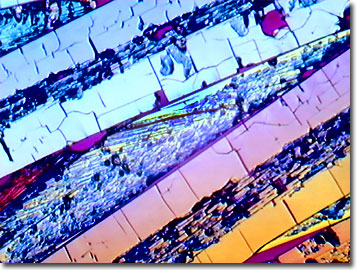Polarized Light Digital Image Gallery
Sulforaphane
When your grandmother told you to eat all your broccoli from the dinner plate, she did not anticipate the findings of biochemists and oncologists that the controversial green vegetable is loaded with sulforaphane, a naturally occurring sulfur-containing isothiocyanate derivative. This phytochemical swings into action within hours of ingestion and triggers an immune response to carcinogenic substances.

View a second image of sulforaphane.
Originally isolated and identified in 1992 by Dr. Paul Talalay of Johns Hopkins University, sulforaphane, one of the mustard oils, is found in broccoli and other cruciferous plants. Unlike water-soluble vitamin C and fat-soluble vitamin E, the indirect oxidant sulforaphane can act in cells throughout the body and its effects may last for several days. Known to biochemists as (R)-1-isothiocyanto-4-methyl-sulfonyl butane, sulforaphane is related to the indoles and is hydrolyzed from its precursor when plant tissues are crushed or chewed. The chiral sulfur compound has been synthesized in the laboratory, but at the commercial scale, is still obtained from plant extracts.
Sulforaphane induces a series of proteins known as phase 2 detoxification enzymes to scavenge for carcinogens before they damage DNA and promote cancer. Broccoli sprouts contain 20 to 50 times the amount of the chemoprotective phytochemicals than the mature heads, according to research pioneered at The Johns Hopkins University School of Medicine. In fact, one variety has been patented by the university because of its maximum concentration. The pungency of some cruciferous vegetables such as broccoli, cauliflower, and kale are due to these sulfur-containing antioxidants.
Breast cancer, prostate cancer, macular degeneration, and hypertension appear to be prevented and treated by sulforaphane. In laboratory experiments with rats exposed to a strong carcinogen, the frequency, size, and number of tumors were dramatically reduced. As a dietary supplement, usually 200 to 400 micrograms of broccoli sprout-derived sulforaphane are taken daily as glucoraphanin or sulforaphane glucosinolate, a metabolic precursor.
Contributing Authors
Omar Alvarado, Thomas J. Fellers and Michael W. Davidson - National High Magnetic Field Laboratory, 1800 East Paul Dirac Dr., The Florida State University, Tallahassee, Florida, 32310.
BACK TO THE POLARIZED LIGHT IMAGE GALLERY
BACK TO THE DIGITAL IMAGE GALLERIES
Questions or comments? Send us an email.
© 1995-2025 by Michael W. Davidson and The Florida State University. All Rights Reserved. No images, graphics, software, scripts, or applets may be reproduced or used in any manner without permission from the copyright holders. Use of this website means you agree to all of the Legal Terms and Conditions set forth by the owners.
This website is maintained by our
Graphics & Web Programming Team
in collaboration with Optical Microscopy at the
National High Magnetic Field Laboratory.
Last Modification Friday, Nov 13, 2015 at 01:19 PM
Access Count Since September 17, 2002: 14144
Visit the website of our partner in introductory microscopy education:
|
|
